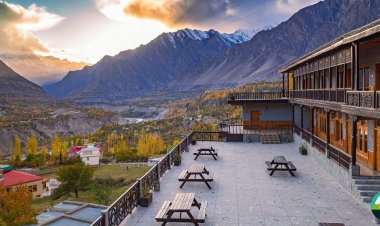Marghazar White Palace in the Swat Valley

Marghazar White Palace located in Swat Valley stands as a historical gem that encapsulates the region's rich heritage. The palace is now a popular tourist destination known for its breathtaking scenery, beautiful interiors, and historical significance.
All About Marghazar White Palace
In this blog, we will take you on a journey through the fascinating history and cultural significance of Marghazar White Palace.
1. Historical Background
The Marghazar White Palace was constructed during the reign of the Wali of Swat, Miangul Abdul Wadood (Badshah Sahib), in the early 1940s. It was built as a royal residence for the Wali and his family, serving both as a summer retreat and a symbol of his authority in the region. The palace's name, "Marghazar," translates to "Meadow of Gazelles," reflecting the lush green surroundings in which it is situated.
2. Architectural Marvel
The Marghazar White Palace is a remarkable example of the fusion of British colonial and Islamic architectural styles. It features white walls with intricate wooden balconies and windows, creating a striking contrast against the backdrop of the Swat Valley's scenic beauty. The design incorporates elements of Mughal and Islamic architecture, making it a unique and visually captivating structure.
The palace also boasts beautiful gardens adorned with a variety of colorful flowers and trees, enhancing its aesthetic appeal and providing a serene atmosphere for visitors to enjoy.
3. Cultural Significance
Marghazar White Palace holds immense cultural significance in Swat Valley. It served as a symbol of the Wali's authority and was often used for hosting important guests and conducting administrative affairs. The palace's role in the region's governance and as a hub of cultural activities makes it an important historical site.
Moreover, the palace has been a witness to several significant events in Swat's history, including meetings between tribal leaders and government officials during the British colonial era and later during Pakistan's early years as a nation.
4. Visiting Marghazar White Palace
Marghazar White Palace is open to the public, allowing visitors to explore its historical significance and architectural beauty. When visiting, be sure to:
-
Explore the palace's various rooms and chambers, some of which are adorned with period furniture and artifacts.
-
Stroll through the picturesque gardens and enjoy the natural beauty of the surroundings.
-
Take in the panoramic views of Swat Valley from the palace's balconies.
-
Learn about the palace's history and significance from knowledgeable guides or informative plaques on-site.
5. Things to Do Nearby
-
Visit the Malam Jabba Ski Resort, which is located about 10 kilometers from the palace.
-
Go hiking or trekking in the surrounding mountains.
-
Visit the Swat Museum, which houses a collection of artifacts from the region's rich history.
-
Visit the Mingora Bazaar, where visitors can shop for souvenirs and handicrafts.
-
Enjoy the delicious local cuisine at one of the many restaurants in the area.
Conclusion
In conclusion, Marghazar White Palace in Swat is a testament to the region's rich history and cultural heritage. Its architectural beauty, historical significance, and efforts toward preservation make it a must-visit destination for those interested in exploring Pakistan's diverse and fascinating history. Whether you're a history enthusiast, an architecture lover, or simply a nature lover, a visit to this enchanting palace is sure to leave you with lasting memories of Swat's glorious past and breathtaking scenery.

















